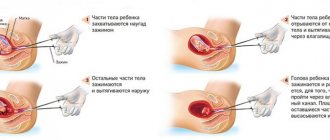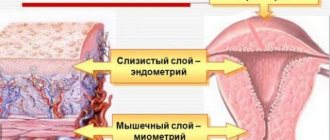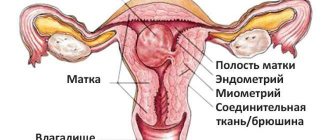Restoring the usual and regular menstrual cycle after fetal death occurs differently for each woman. The first menstruation should not be confused with lochia, a discharge that appears immediately after cleansing. When to expect your first period after a missed pregnancy, how does cleansing affect the course of menstruation, and what is considered normal and what is an anomaly? More on this later.
Physiological recovery
A frozen pregnancy is an unnatural (abnormal) development of a fertilized egg, as a result of which the fetus does not develop or does not correspond to the gestational age previously established by test results. The process of rehabilitation of the body after cleansing in physiological terms will depend on the reasons that led to the death of the fetus.
The most important process on the path to recovery is the appearance of the first menstruation. Do not confuse bleeding (lochia) after cleansing with the menstrual cycle. The first discharge is the cleansing of the uterine body from naturally accumulated blood. Menstruation is the preparation of the uterus for subsequent pregnancy.
The first menstruation should appear no later than two months after the cleansing of an unsuccessful pregnancy.
How do menstruation behave after the intervention?
The nature of menstruation after curettage may change briefly. This is influenced by the woman’s age and the professionalism of the doctor who performed the curettage. The general condition of the woman and the period at which the fetus died should be taken into account.
The cycle can resume in 3-4 months in a woman who has previously given birth. If there was no birth, the process can take up to 7 months. During this period, it is necessary to undergo preventive examinations and follow the doctor’s recommendations for recovery.
Abundance
Many people experience heavy periods after cleansing a frozen pregnancy. The woman changes her hygiene products after about 3 hours; at night, the discharge does not become less abundant. After curettage, this is an alarming symptom that can be provoked: after curettage, this is a common occurrence in most cases and should not cause alarm. The inner layer of the endometrium cannot recover immediately; sometimes ovulation does not even occur in the first cycle, hence the scarcity of discharge.
You should consult a doctor when your periods begin with a strong delay and they are very scanty. Often this is a sign of an inflammatory process in the ovaries, stenosis of the uterine cervix. Blood cannot escape due to the narrowing of the cervical canal, and the process is accompanied by pain.
Is pain possible?
Full restoration of the cycle after a frozen pregnancy requires some time. Severe pain may accompany menstruation for the first 1-3 cycles. During this period, the uterus is especially sensitive to contractions. Severe pain also occurs due to hormonal imbalances. Large amounts of dopamine and adrenaline cause a sharp contraction of the smooth muscles of the uterus. Gradually the condition returns to normal.
After curettage, normal menstruation returns after a few cycles. A woman must strictly follow the doctor’s recommendations during the recovery period in order to maintain reproductive health.
After fetal freezing, it happens differently for each woman. The first menstruation should not be confused with lochia, a discharge that appears immediately after cleansing. When to expect your first period after a missed pregnancy, how does cleansing affect the course of menstruation, and what is considered normal and what is an anomaly? More on this later.
– this is the unnatural (abnormal) development of a fertilized egg, as a result of which the fetus does not develop or does not correspond to the gestational age previously established based on test results. The process of the body after cleansing in physiological terms will depend on the reasons that led to the death of the fetus.
The most important process on the path to recovery is the appearance of the first menstruation. Do not confuse bleeding (lochia) after cleansing with the menstrual cycle. The first discharge is the cleansing of the uterine body from naturally accumulated blood. Menstruation is the preparation of the uterus for subsequent pregnancy.
The first menstruation should appear no later than two months after the cleansing of an unsuccessful pregnancy.
Periods after cleansing
People often confuse the concept of “menstruation” with the definition of “lochia”, believing that they are the same thing. The main difference between these processes is that in the first case the body is cleansed, and in the second it prepares for a new fertilization. The duration of lochia is approximately 2-3 weeks. While menstruation (including after a frozen pregnancy) is a normal process for a woman, with a characteristic intensity and duration.
When will they start
After an unsuccessful frozen pregnancy, the cause of this tragedy should be identified. So, if the blame lies entirely with infectious agents (toxoplasmosis, herpes, influenza), then initially it is worth eliminating the development of the pathogenic process and only then expect the normal formation of the previous menstrual cycle.
If a pregnant woman is infected with toxoplasmosis or chickenpox for the first time, then in 99% of cases we can talk about the interruption of the “interesting situation”. If the fetus does not die, then life-incompatible pathologies of the heart, kidneys, and liver are formed.
If a woman has completed all the necessary procedures and even a course of treatment, then she should expect her first period no later than 60 days after cleansing. As a rule, menstruation after a frozen pregnancy occurs at the end of the next calendar month.
The menstrual cycle may be unstable for the first six months. This is due to the hormones that are produced during pregnancy. However, menstruation should occur once every month and a half.
When does your period start after surgery?
Scraping is a shock for the woman and the body. It is important that the opportunity to become pregnant and give birth to a child was preserved. Doctors cannot say exactly when your period will start.
The first day of a new cycle is considered to be the day of curettage. The first menstruation after curettage of a frozen pregnancy will begin when the upper uterine layer is completely restored and the normal process of rejection occurs, menstruation begins. On average, your period should begin 28-35 days after surgery.
Doctors warn when they begin not to perceive them as menstruation. This may be a sign that the organ whose surface was scraped is beginning to recover. The time when your period comes depends on the duration of pregnancy; the longer it was, the longer you have to wait for a new menstruation. The timing of their appearance is influenced by the woman’s age and the general condition of the body. When they begin, a woman should carefully monitor the nature of the discharge. There should be no increased discomfort, severe pain, and there should be no unpleasant odor from the discharge. These signs indicate the development of an infection in the uterus; this condition requires timely treatment.
Menstruation disorders
If there is an infection, the doctor will prescribe tests, and you may have to donate blood for hormones. If menstruation after a frozen (early or late) pregnancy does not begin in the first two months after curettage or is not stable (abundant or scanty), then it is worth talking about anomalies and menstrual irregularities.
Scanty discharge
Weak discharge after pregnancy has ended is also an anomaly that should be examined by a gynecologist. There are a number of factors worth paying attention to.
- Weight. Most often, scanty periods (if they were previously normal) are observed in women with insufficient body weight; secondary reasons in this situation are exhaustion and anemia.
- Psycho-emotional state. If, after the pregnancy fading, the doctor prescribed strong sedatives, and the woman in labor still complains of severe stress, sleeps poorly, and suffers from lack of appetite, then it is worth talking about prolonged depression, which is treated additionally.
- State of hormones. Hormonal problems lead to changes in the duration and intensity of discharge after pregnancy ends.
- Severe endometrial hypoplasia in the uterus can also cause weak discharge.
Delay
Persistent inflammatory processes, infectious diseases and complications after pregnancy fading can lead to the fact that menstruation will initially be weak, inconsistent, and then completely disappear. You should not worry if the reason for the lack of blood during the new menstrual cycle is hormonal changes (as a rule, it takes no more than two months).
A dangerous condition for a woman’s body and health is the absence of menstruation for several cycles. This disease is called amenorrhea. There are several types, each of which is treated differently.
Amenorrhea is the absence of natural menstruation for a woman for 6 months. It can occur due to hormonal imbalance, as well as against the background of stress after pregnancy fading.
Heavy discharge
Heavy periods with dark blood clots should also be considered an anomaly. The reason for this condition may be:
- cervical spasm is a life-threatening condition;
- developed inflammatory process;
- damage to the uterine mucosa (error during curettage);
- damage to the basal (deep) layer of the uterus;
- heavy physical activity of a woman in the first month after a frozen pregnancy;
- cervical rupture (in case of clandestine operation in dubious centers);
- sexual intercourse in the first month after cleansing;
- tissue remains (fertilized egg, fetus) in the uterine cavity;
- ectopic pregnancy;
- visiting the pool, sauna in the first month after cleaning.
Heavy periods and bleeding are different concepts. The latter threatens a woman with death, manifests itself no later than two weeks after cleansing, and is often accompanied by a rise in temperature and loss of consciousness.
Separately, it is worth emphasizing hygiene after curettage: the woman in labor must constantly ensure that blood clots do not accumulate, and for this she needs to walk more often, and not lie in bed all the time.
It is forbidden to use tampons in the first three months after curettage. This can cause inflammation of the external genitalia and uterus.
How many days does menstruation last?
Menstruation after a frozen pregnancy occurs approximately 28-35 days. Their course of action may differ. This is explained by surgical intervention, stress on the body, and hormonal imbalance. A woman definitely needs to know how many days her period lasts in order to understand whether there is cause for concern.
The norm for a healthy woman is menstruation lasting 3-7 days; after curettage, this period may increase by a couple of days, but gradually the cycle will return to normal.
If after the procedure there is bleeding that lasts 2 weeks or more, you need to inform the doctor - this is not menstruation, but a sign of recovery of an injured organ or evidence of the presence of internal inflammatory processes or diseases.
First menstruation after curettage
The first couple of months, the cycle may be unstable, discharge with an odor or a brown tint. This is all considered normal, there is no need to panic. The first menstruation occurs one and a half months after cleansing, and all subsequent menstruation acquires the same frequency and intensity.
Often, a gynecologist prescribes pills to stabilize the cycle and provide additional protection against pregnancy, Lindinet.
Timing and duration
The duration of the menstrual cycle in the absence of infectious diseases does not differ from previous periods: the normal frequency is 26-36 days, the length is 4-7 days. If there are no alarming symptoms (temperature, unpleasant odor), then there is no need to worry.
After urgent curettage
Curettage can be carried out both planned and urgently. The latter is required in the presence of aggravating symptoms.
- The appearance of a high temperature in the absence of signs of pregnancy. The diagnosis is confirmed by ultrasound.
- Pregnancy is contraindicated due to a threat to the woman’s life or Rh conflict.
- Signs of fetal rotting appeared (with prolonged absence of medical care).
- Development of acute symptoms of an infectious disease.
- Poisoning of the body as a result of the fading and decomposition of the fetus inside the uterus.
Carrying out curettage in such cases is a mandatory procedure that will save a woman’s life. If pregnancy was accompanied by complications, inflammatory or purulent processes of the reproductive organs, then menstruation may initially be heavy.
Alarming symptoms
The duration of bleeding after pregnancy fading should not exceed normal periods. Warning signs after curettage:
- throbbing, increasing pain in the lower abdomen;
- nagging, characteristic spasm, pain in the lower back;
- numbness of toes, hands;
- purulent discharge;
- unpleasant odor;
- a large number of blood clots;
- scarlet blood with black streaks;
- heat;
- disorientation of consciousness;
- swelling;
- copious bleeding after scanty discharge.
If a woman follows all the recommendations, leads a normal lifestyle, and also excludes sexual intercourse in the first month, then she will not be afraid of all these complications.
The first period after cleansing is an important indicator of women's health. If your menstrual cycle is delayed for seven or more weeks, you should tell your doctor about this, because this phenomenon may indicate a serious disorder that requires immediate medical intervention.
The first period after a frozen pregnancy: when to be wary
As a rule, after curettage, they continue for 2-3 days. They cannot be called abundant, but they cannot be called smearing either. This behavior of the body is the norm, since after ST the functionality of the female organs should be restored and thus the uterus cleanses itself.
If after 3 days (maximum 7 days) blood is still flowing, you need to contact a gynecologist. Many girls confuse their first period with discharge after curettage.
Bloody discharge after cleansing for several days is not menstruation!
About fetal freezing
The reasons for the cessation of embryo development are not precisely determined. Sometimes the culprits are:
- Uncontrolled use of medications;
- Infections;
- Harmful addictions;
- Nervous shocks.
But even those women whose pregnancy proceeds without such negative accompaniment are not immune from pregnancy fading.
It is not always possible to detect a problem immediately and on your own. An important point that may interest women is whether menstruation can occur during a frozen pregnancy. Everyone knows that one of the signs of its normal course is precisely their absence.
Freezing of the fetus means that it no longer requires nutrition. The membranes do not release hCG, that is, the mother’s body receives a signal about this. Normal embryo development is supported by the hormone progesterone. Now its volume decreases, which causes partial rejection of the endometrium. Frozen pregnancy and spotting or more severe discharge with paroxysmal pain is a common combination. Based on this sign, one can suspect an unfavorable development of the condition, especially if there are:
- Abrupt disappearance of toxicosis;
- Return to the previous appearance and condition of the mammary glands;
- Decrease in basal temperature.
What to do?
There is no way to push an embryo towards normal development. It is necessary to get rid of it and restore the woman’s health. Her chances of becoming a mother in the future are no less, but rehabilitation takes time.
Keeping in mind the discharge that occurs when the development of the fetus stops, women worry whether a frozen pregnancy can come out with menstruation. This is very likely, especially at an early stage. The woman may not be aware of her situation, and a late menstruation will be nothing more than a miscarriage.
Some doctors, having made a diagnosis, wait until the patient’s body copes with it on its own. But even if a woman is sure that the miscarriage was complete and her uterus rejected the frozen fetus, monitoring this with an ultrasound is still necessary.
In most such cases, curettage is performed, and after a couple of weeks an ultrasound examination is performed to monitor the condition. After surgery, antibiotic therapy and hormonal agents are often prescribed.
It is not surprising that menstruation after curettage of a frozen pregnancy may proceed differently than before. There are many external and internal reasons influencing this.
We recommend reading the article about menstruation after a miscarriage. You will learn about the beginning of menstruation, the nature of discharge, and the normalization of the menstrual cycle after an unsuccessful pregnancy.










